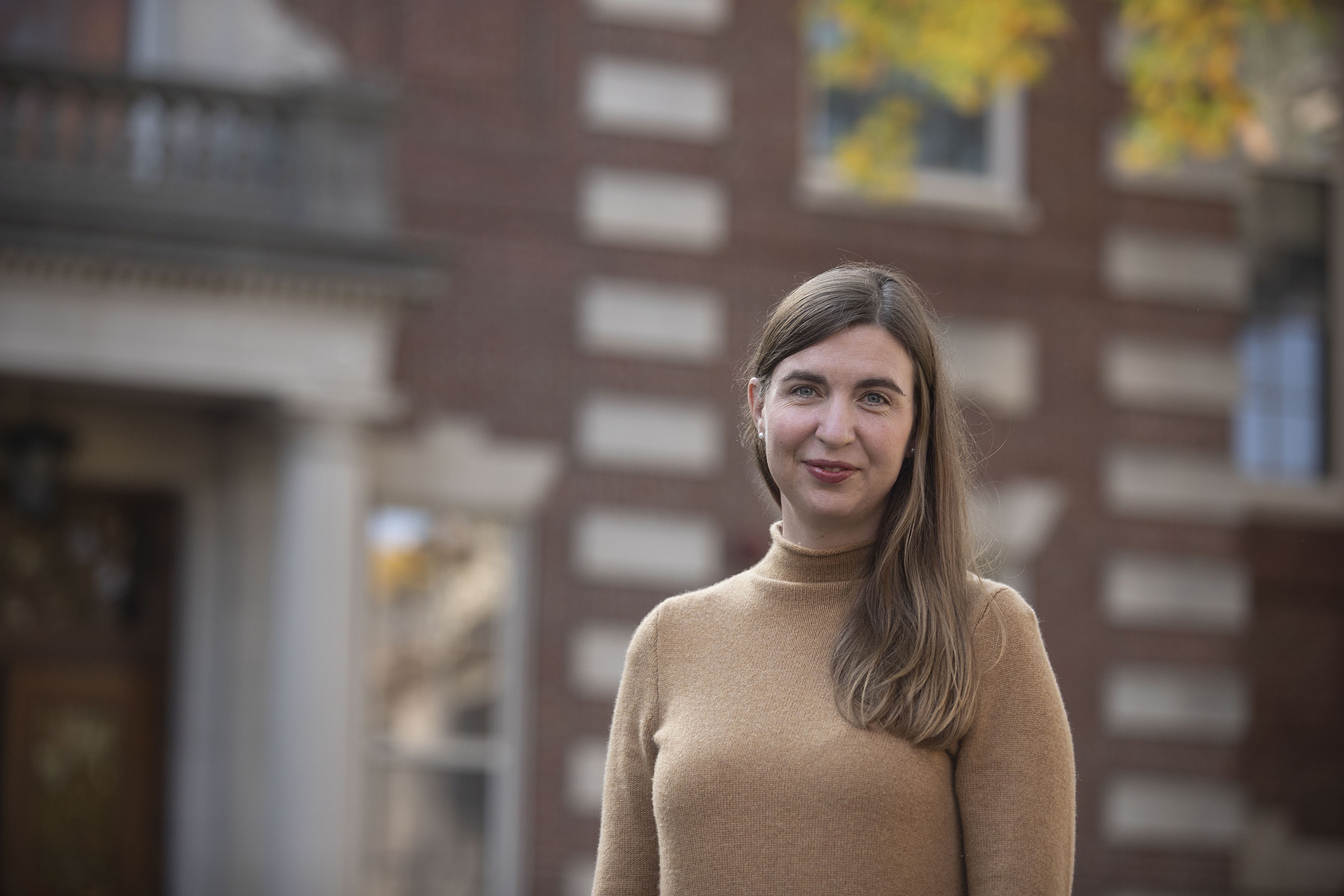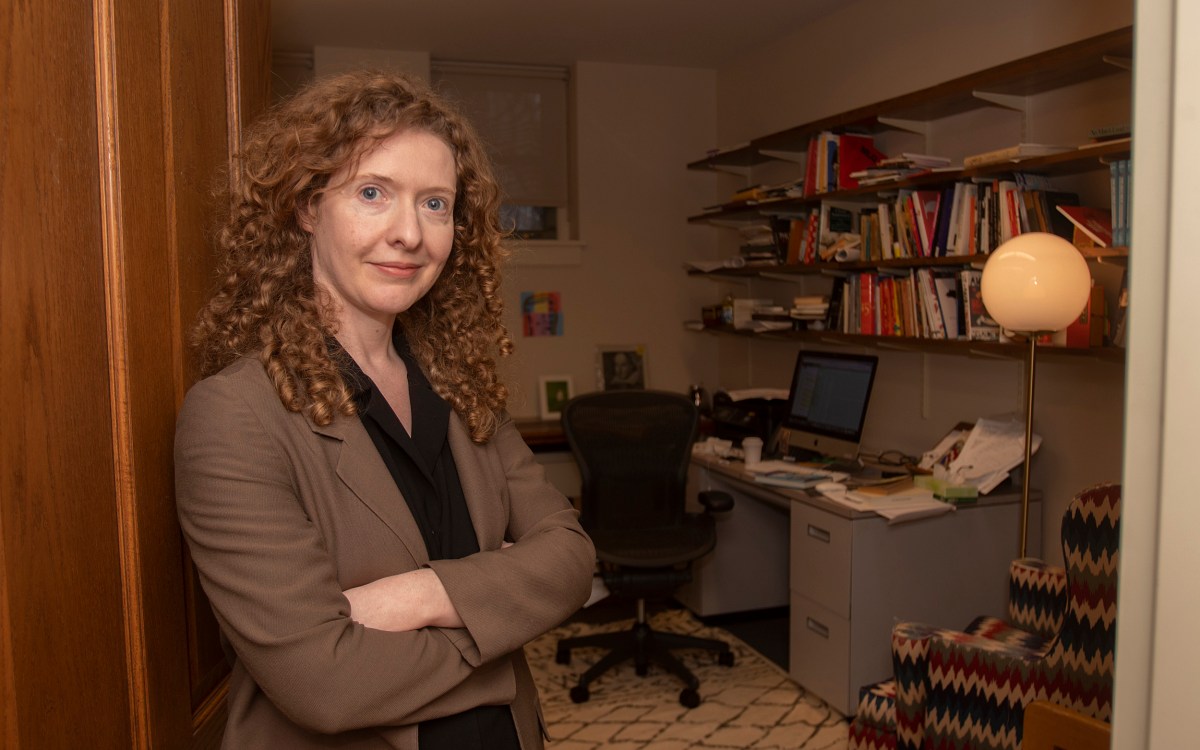
Assistant Professor Sarah Dimick’s lecture course, “Voices of Environmental Justice,” considers the relationship between systems of human injustice and environmental issues.
Kris Snibbe/Harvard Staff Photographer
New faculty: Sarah Dimick
Understanding connections between literature and the environment
Sarah Dimick wants to expand our understanding of environmental literature beyond traditional narratives that extol the beauty of the natural world or wallow in apocalypse. In her teaching and research, the assistant professor of English (who joined the department last year) analyzes themes of displacement, resistance, and justice in novels, poetry, nonfiction, and memoir. Dimick spoke to the Gazette about how she got started and the ways that literature can enlighten our understanding of the past, present, and future under climate change.
Q&A
Sarah Dimick
Gazette: When did you first become interested in the intersections of environmentalism, climate change, and literature?
Dimick: Much of my work in this area began when I was an undergraduate student. I spent the summer after my sophomore year in college working as a backpacking guide in the Absaroka-Beartooth mountains in Montana. I had a conversation on the trail with a man who had been herding sheep in those mountains for decades, and he explained that the glaciers in that area were receding at an alarming rate. He never used the words climate change, but he was acutely aware that his home landscape was undergoing this dramatic shift. He was concerned about the availability of water.
The following summer, a fellowship allowed me to travel to the Himalayas, working with a women’s collective located near Dharamsala, India. As they embroidered items to sell, the women spoke about how the glacier just up the mountain was receding quite quickly. I was struck by the way these stories emerging in two very different areas of the world were starting to resonate and potentially speak to each other.
Gazette: How can literature help us understand the lived realities of climate change?
Dimick: I have such admiration and respect for my colleagues in climate science, and I think their work, especially right now, is an incredibly brave undertaking. At its best, literature helps us remember that climate change is not simply a change in the composition of our atmosphere. Climate change is also a change in our practices of mourning and remembrance, a change in how we understand our history. It changes the ways that our lives are entangled with the lives of others, particularly as we look ahead to a future of displacement and precarity. These changes alter the ways we locate meaning within our lives, and literature can help us navigate crumbling ideas and imagine routes towards more equitable futures.
Gazette: You analyze and teach on these themes in many areas including nonfiction, contemporary and historical fiction, and poetry. Why do you think it’s important to explore these issues across genres?
Dimick: Often, when I describe what I do, people will say, “Oh, you work on cli-fi,” the shorthand for climate fiction. I do appreciate that emphasis on the speculative [in that genre]. But I think it’s crucial to consider the capacities of other genres and forms: poetry, creative nonfiction, memoir, and realist novels. They open other possibilities and are attuned to different audiences.
Last semester, I was struck by the way that my students gravitated toward climate poetry. Repetitions and anaphora provided a weight — a certain heaviness — that students felt was necessary as they read through a semester of wildfires and unrest. I also think nonfiction environmental writing is absolutely crucial and understudied. I enjoy teaching “Rising: Dispatches from the New American Shore” by Elizabeth Rush. It collages voices from coastal communities in the United States, reminding us that the climate crisis is not a futuristic event but something already underway.
Gazette: Can you talk about the courses you’ll be teaching this spring?
Dimick: My lecture course, “Voices of Environmental Justice,” considers the relationship between systems of human injustice and environmental issues. We’ll be looking at literary portrayals of industrial disasters, ocean acidification, and resource extraction. We’re reading Ken Saro-Wiwa’s “A Month and a Day: A Detention Diary.” Saro-Wiwa recounts how he and other Ogoni activists organized a resistance movement against Shell Oil. As Shell and other international oil companies siphoned profits away from the Niger Delta, Saro-Wiwa framed the extinction of human communities as an environmental issue. He was executed for his activism in 1995, but his voice and ideas persist in his writing.
I’m also teaching a seminar called “Resisting Toxicity: Rachel Carson, Dolores Huerta, and Environmental Nonfiction.” Carson wrote “Silent Spring” and Huerta co-founded the United Farm Workers. Through their writing and organizing, both of these women campaigned against toxic exposures in the mid-20th century United States, but they are rarely studied together. Carson and Huerta offer us two distinct, but vital examples of environmental rhetoric. Carson crafted a meticulously researched case against the profligate use of DDT, publishing with Houghton Mifflin, while Huerta’s speeches and negotiations built a movement against cancer clusters and pesticide poisonings in California’s farm fields. I think they’re powerful complements and counterpoints to each other, and I’m grateful to have the chance to consider their work and their legacies with my students.







